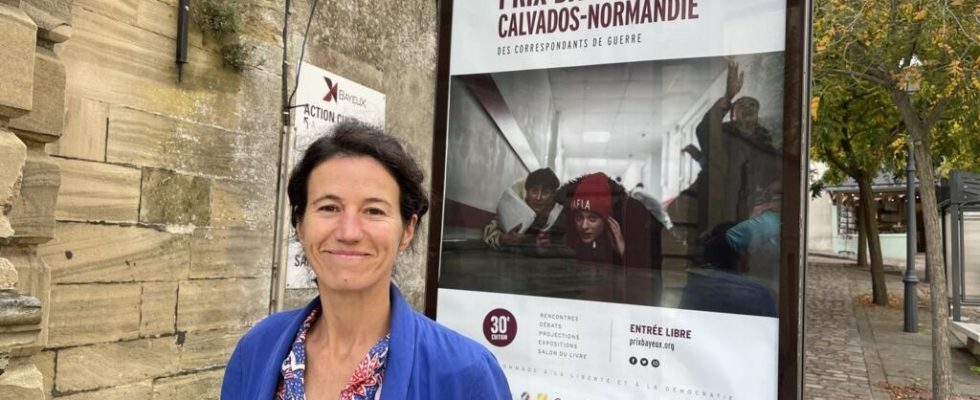Director Claire Billet will present her documentary “Woman, Life, Liberty – An Iranian Revolution” on Sunday October 15 during the 30th edition of the Bayeux Prize in Normandy. Co-directed with Mohamad Hosseini, this documentary retraces a year of unprecedented mobilization, thanks to numerous amateur videos, stories from young demonstrators, exiled Iranians and the testimony of Narges Mohammadi, Nobel Peace Prize 2023, transmitted since Evin prison. A poignant and very educational film. Interview.
5 mins
From our special correspondent in Bayeux,
RFI : What was your objective in filming this documentary for the Arte channel? ?
Claire Billet : We had in mind to show what was unique about this movement, by being on the side of the people of the “Woman, Life, Liberty” movement and to illustrate the rise in power of this movement. We wanted to show this tipping point that was being created, with no way back.
The idea was to delve into the beginnings of a revolution. We wanted to go back to the flow of information and especially images that there was on social networks to understand how this movement was structured.
How did you make it ?
This documentary is above all a collective work. I worked with a co-director, who remained anonymous, and with several collaborators in five different countries. There were a lot of people working on this film – around a dozen people, but for security reasons, the Iranians could not give their real identities. They chose, in a sort of homage, to appear in the credits taking the names of people killed during demonstrations or during executions.
We couldn’t film in Iran. We recorded people who had stayed in the country, protecting them as much as possible. The idea was to combine the images taken on cell phones – which was the only way for the Iranians to make the world understand what was happening in their country – with the words of the people who acted in this movement. And to give voice to the exiled Iranian diaspora. We realized at the same time that the events were taking place. Over time, we worked with a growing mass of videos. For several months, I received dozens of videos per day. These were videos collected by our team the day before, on social networks, videos released by activist networks.
The film was intended to be engaged, but not militant. We wanted to dive into the side of the demonstrators, while maintaining a neutral foundation in the way we told the events. We spent a lot of time verifying the information, cross-checking it, authenticating the videos.
I also spent a lot of time chatting with young people in Iran, on secure messaging services, to understand their movement. It was important to highlight the words of these young people. It was also important to have the perspective and analysis of exiled people from the diaspora, who sometimes have a slightly more historical point of view and allow us to understand how we got here today.
In your documentary, Iranian actress Golshifteh Farahani, exiled in France, explains that she is very impressed by the courage of the young generation of Iranians who took to the streets after the death of Mahsa Amini.
Yes. As Golshifteh Farahani explains in the documentary, she is part of the generation underground, there “ basement generation “. A generation traumatized not by the Islamic Revolution of 1979, but by the Iran-Iraq War (1980-1988). Golshifteh says that they did a lot of things in secret, that they found spaces of freedom in clandestinity. Today’s Iranian youth have not experienced the violence of war, they do not have this fear within them. In the images that reached us, what struck me was that the fear seemed to have changed sides.
The Iranians are constantly adapting and they are very fast. This generation, which is that of social networks, knows how to use mobile phone tools very well. Very quickly, they understood that it was no longer necessary to identify people in the videos because it put them in danger. Very quickly, the videos were blurred, either directly during filming, or afterwards before being sent back to the networks or even framed so that the faces did not appear. They no longer went out with their cell phones and avoided keeping videos so as not to be incriminated if they were arrested. They are also very afraid of facial recognition.
Your documentary is punctuated by the reading of a letter from Narges Mohammadi, 2023 Nobel Peace Prize winner and currently imprisoned in Evin prison in Tehran. How did you manage to communicate with her?
I sent questions and she found ways to answer them. Golshifteh Farahani was then asked to read some extracts from it. Narges Mohammadi is someone very well known in Iran. There are a few prisoners like that who are emblematic prisoners and who disturb the regime because their voice is extremely heard in the country. She is imprisoned, she comes out, she continues to fight, she is imprisoned, she comes out, she does not give up.
There is a resistance network which is really strong and present throughout the territory. This solidarity network does everything to ensure that messages can get out of Iran.
Today, the population has moved to civil disobedience. The street is less busy, there were many preventive arrests for the anniversary of Mahsa Amini’s death. Even if the tipping point has not yet occurred, it is a question of time.
Read alsoNobel Peace Prize winner Narges Mohammadi is “an exceptional and determined personality”
► The documentary “ Woman, Life, Freedom – An Iranian Revolution » is available in replay on the Arte website until December 23, 2023. It will be screened and followed by a meeting with Claire Billet, Sunday October 15, 2023 in Bayeux, at the Pavillon, Place Gauquelin Despallières.
